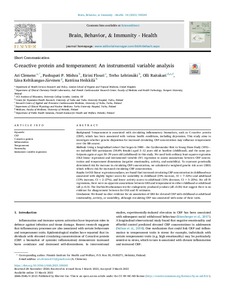C-reactive protein and temperament: An instrumental variable analysis
Clemens Ari; Mishra Pashupari P; Flouri Eirini; Lehtimäki Terho; Raitakari Olli; Keltikangas-Järvinen Liisa; Heikkilä Katriina
https://urn.fi/URN:NBN:fi-fe2022012710807
Tiivistelmä
Background: Temperament is associated with circulating inflammatory biomarkers, such as C-reactive protein (CRP), which has been associated with various health conditions, including depression. This study aims to investigate whether genetic disposition for increased circulating CRP concentration may influence temperament over the life-course.
Methods: Using a longitudinal cohort that began in 1980-the Cardiovascular Risk in Young Finns Study (YFS)-we included 920 participants (59.8% female) aged 3-12 years old at baseline (childhood), and the same participants again at ages 30-39 years old (adulthood) in this study. We used both ordinary least-squares regression (OLS linear regression) and instrumental variable (IV) regression to assess associations between CRP concentration and temperament dimensions (negative emotionality, activity, and sociability). To represent genetically determined risk for increase in circulating CRP concentration, we calculated a weighted genetic risk score (GRS) which reflects risk for increased circulating CRP concentration.
Results: In OLS linear regression analyses, we found that increased circulating CRP concentration in childhood was associated with slightly higher scores for sociability in childhood (19% increase, CI = 7-32%) and adulthood (13% increase, CI = 2-27%), and lower activity scores in adulthood (15% decrease, CI = 3-25%). For all IV regressions, there were no apparent associations between GRS and temperament in either childhood or adulthood (all p>0.3). The Durbin-Wu-Hausman test for endogeneity produced p-values (all>0.05) that suggest there is no evidence for disagreement between the OLS and IV estimates.
Conclusions: We found no clear evidence for an association of GRS for elevated CRP with childhood or adulthood emotionality, activity, or sociability, although circulating CRP was associated with some of these traits.
Keywords: C-reactive protein; CRP; Inflammation; Instrument variable regression; Personality; Temperament.
Kokoelmat
- Rinnakkaistallenteet [27094]
